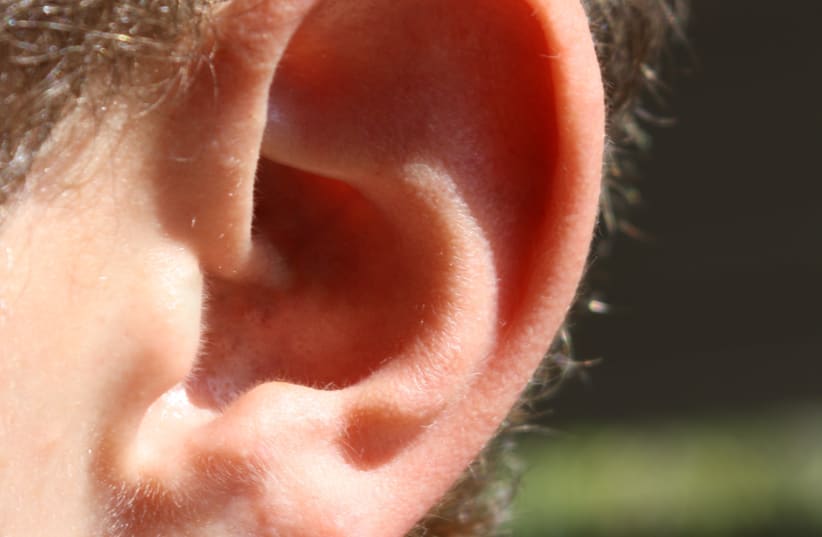Off the top of my head, I can come up with more much more than a handful of mind-boggling terms and expressions whose origins I can’t quite put my finger on, but I could play it by ear. However, I don’t want to put my foot in my mouth and end up red in the face.
As Judge Judy Sheindlin would say, “Do you get where I’m going?”
“Do you get where I’m going?”
Judge Judy Sheindlin
There are scores of idioms and expressions that relate to parts of the body. So let’s eyeball the situation and get to the heart of the matter.
We’ll take it from the top and work our way down.
For starters, the expression “head over heels” means “completely” or “thoroughly” as in the familiar phrase “They fell head over heels in love.” The expression originated in the 1300s as “heels over head” and meant literally being upside down. It took its present form in the 1700s and its present meaning in the 1800s.
The expression “by a hair’s breadth” means “by an extremely small distance or margin.” The word “breadth” comes from the Old English word brædu, which meant “width.” Paired with “hair,” the term denotes a distance that is extremely thin or narrow. In fact, a hair’s breadth was once a unit of measurement that equaled one-forty-eighth of an inch.
“The apple of one’s eye” describes a thing or person that someone cherishes. The phrase dates back to the ninth century.“Apple” referred to the pupil of the eye. In a time without proper eye care, sight was a precious commodity. Thus “the apple of one’s eye” became a metaphor for something held dear.
“To give one’s eye teeth” means to offer something precious in order to gain something or be something. The eye teeth are the canines. As they are located directly below the eyes, they’re called the eye teeth. Centuries ago, eye teeth were considered very important, indicating that a child had grown his full set of teeth. When he had his eye teeth, he was fully alert with the wisdom of an adult.
“Tongue-in-cheek” describes an exaggerated facial gesture. Pushing a cheek out with one’s tongue is meant to convey contempt or irony. The action is thought to have originated as a theatrical device, a technique for an actor to indicate that a statement was meant to be sarcastic or humorous.
The idiom “Are your ears burning?” comes from the belief that a person’s ears burn when others are discussing him when he isn’t present. This dates back to ancient Rome. The Romans believed that if the right ear was burning, people were giving the person praise. If the left ear was burning, it meant that people were criticizing the person. Some think this belief started because people often flush with embarrassment when they hear something positive or negative about themselves, and their ears become red.
“To pay through the nose” means to pay too much money for something. A “nose count” is a tally to see how many people are present. The origin of the term dates back to the 9th century, when the Danish conquered Ireland. The Danes carried out a census by counting noses so they could decide how to tax their new subjects. They imposed exorbitant taxes on each “nose,” thus one had to pay through the nose. Taking the reference one step further, those who didn’t pay the ounce of gold were punished by having their nose slit.
And speaking of paying, “to pay lip service” means to promise to do something but not do it or to make statements of support that are insincere. The phrase emanated in the 1500s. At that time, it was used primarily to describe prayers that were insincere.
The term “redneck” refers to a working-class white person, especially a political reactionary from a rural area. It was originally applied to rural white Americans of the Southern United States who were perceived to be crass and unsophisticated. Dating back to the late 19th century, the term referred to the sunburn on farmers’ necks.
The Adam’s apple is the protrusion in the neck formed by the angle of the thyroid cartilage surrounding the larynx, most commonly visible in men, less frequently in women. It is postulated that the Latin phrase pomum Adami (“Adam’s apple”) was a mistranslation of the Hebrew tapuach ha’adam, meaning “male bump.” The confusion arose because in Hebrew, the name Adam means “man,” and the word for “apple” (tapuach) is similar to the word tafuach, which means “swollen.” Hence, the combination “the swelling of a man.” In much earlier times, it was a popular belief that as a reminder of his having eaten the forbidden fruit, a piece of the apple remained lodged in Adam’s throat.
If someone “gets the cold shoulder,” it means he is intentionally ignored or treated in an unfriendly way. Although the image of a person being snubbed by having someone turn his back on him fits the phrase, there is another, interpretation of the derivation, According to folklore, welcome visitors to a home were served a hearty hot meal, but those who weren’t so welcome were given a cold shoulder of mutton or beef. Thus an unwelcome guest or wayfarer “got the cold shoulder.”
To keep someone “at arm’s length” means to keep them away from you and deter them from getting too close. In the past, people used body parts to measure various distances (such as “a foot”). In general, the correct etiquette was to bow or curtsy at a slight distance. To invade someone’s personal space was considered rude or disrespectful in most situations, especially among the upper classes.
And speaking of being rude, we all learned from an early age that it’s impolite to put our elbows on the table. But in fact, the origin of that caveat was not a question of etiquette but of equilibrium. In the Middle Ages, particularly in England, dining tables were trestled; thus they were not solid, with no fixed base. The trestle was covered with a cloth before dining to give it a more elaborate appearance. Platters of food were placed on one side (length) of the table, and the guests were seated on the other side along the length of the table. If the guests leaned on the table in any way or placed their elbows on it, the table could collapse. Hence the rule of no elbows on the table.
“To lend a hand” means to help or assist, especially voluntarily. In the past, most labor was manual labor, so when people lent someone a hand, they were giving up their precious time to help someone else and not be paid for their work.
The handshake has existed in some form or another for thousands of years. One popular theory is that the gesture began as a way of conveying peaceful intentions. By extending their empty right hands, strangers could show that they were not holding weapons and bore no ill will toward one another. Some suggest that the up-and-down motion of the handshake was supposed to dislodge any knives or daggers that might be hidden up a sleeve. Yet another explanation is that the handshake was a symbol of good faith when making an oath or promise. When people clasped hands, they indicated that their word was a sacred bond.
The smallest finger on the hand is called the “pinkie.” The word “pinkie” is derived from the Dutch word pink, which means “little finger.” As a note of interest, it is almost impossible for most people to bend the pinkie independently without also bending the ring finger next to it.
In the US, to have “a green thumb” means to have a keen ability to make plants grow. The term is associated with England’s King Edward I, who enjoyed eating fresh green peas. He was said to give prizes to the serf who could display the greenest thumb from shelling them. The British term “green fingers” is said to have originated in the early 1900s. It is believed to come from the green stains that farmers and crop growers acquire on their fingertips when they handle plants regularly.
If something costs “an arm and a leg,” it means it is very expensive. Fortunately, the origin of that expression is not as gruesome as it sounds. The phrase originally derives from the Irish 1/2d (“d” from the Roman denarius) coinage of King Charles II. In 1680, the king granted letters patent to Sir Thomas Armstrong and Colonel George Legge to manufacture copper halfpennies for use in Ireland.
In that vein, if someone is “worth his weight in gold,” it means he is so helpful or valuable that you feel you couldn’t manage without him. That metaphoric term dates from Roman times and appeared in English by the early 1300s.
And on that positive note, we’ll end this exploration of anatomical explanations. Hope it was interesting and insightful. Fingers crossed. ■

